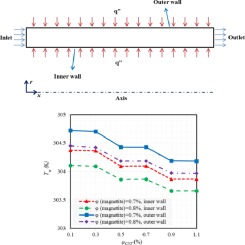Journal of the Taiwan Institute of Chemical Engineers ( IF 5.7 ) Pub Date : 2018-01-17 , DOI: 10.1016/j.jtice.2017.12.029 Amin Shahsavar , Mehdi Moradi , Mehdi Bahiraei

|
This research attempts to investigate the effects of concentration and radius ratio on convective heat transfer and entropy generation of a non-Newtonian hybrid nanofluid flowing through a concentric annulus. The nanofluid is prepared by suspending tetramethylammonium hydroxide (TMAH) coated Fe3O4 (magnetite) nanoparticles and gum arabic (GA) coated carbon nanotubes (CNTs) in water. Variable thermal conductivity and viscosity are used in simulations. The convective heat transfer coefficient of inner and outer walls, and total entropy generation augment with increasing Fe3O4 and CNT concentrations. Increasing radius ratio from 0.2 to 0.8, at CNT concentration of 1.1% and Fe3O4 concentration of 0.7%, decreases the heat transfer coefficient of inner wall by 85.05%, while increases that of outer wall by 35.49%. Models of convective heat transfer coefficient of both walls and total entropy generation are developed using neural network. Genetic algorithm is used with compromise programming to achieve optimal cases with maximum heat transfer and minimum entropy generation. In this method, the objective functions are mixed and the problem transforms into a single-objective optimization. Finally, applying the nanofluid with high concentrations is recommended for all conditions except the cases in which importance of entropy generation is considered much greater than that of heat transfer.
中文翻译:

包含涂层的CNT / Fe 3 O 4纳米粒子的非牛顿杂化纳米流体在同心环空中流动的传热和熵产生优化
这项研究试图调查浓度和半径比对流过同心环空的非牛顿混合纳米流体的对流传热和熵产生的影响。通过将四甲基氢氧化铵(TMAH)涂覆的Fe 3 O 4(磁铁矿)纳米颗粒和阿拉伯胶(GA)涂覆的碳纳米管(CNT)悬浮在水中来制备纳米流体。模拟中使用了可变的导热系数和粘度。内壁和外壁的对流传热系数以及总熵的产生随着Fe 3 O 4和CNT浓度的增加而增加。在碳纳米管浓度为1.1%和Fe 3 O 4的情况下,半径比从0.2增加到0.8浓度为0.7%时,内壁的传热系数降低85.05%,外壁的传热系数提高35.49%。利用神经网络建立了两壁对流换热系数和总熵产生的模型。遗传算法与折衷编程一起使用,以实现具有最大热传递和最小熵产生的最佳情况。在这种方法中,目标函数混合在一起,问题转化为单目标优化。最后,建议在所有条件下都使用高浓度的纳米流体,除非认为熵产生的重要性远大于传热的重要性。


























 京公网安备 11010802027423号
京公网安备 11010802027423号